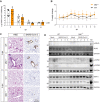Necroptosis does not drive disease pathogenesis in a mouse infective model of SARS-CoV-2 in vivo
- PMID: 38286985
- PMCID: PMC10825138
- DOI: 10.1038/s41419-024-06471-6
Necroptosis does not drive disease pathogenesis in a mouse infective model of SARS-CoV-2 in vivo
Abstract
Necroptosis, a type of lytic cell death executed by the pseudokinase Mixed Lineage Kinase Domain-Like (MLKL) has been implicated in the detrimental inflammation caused by SARS-CoV-2 infection. We minimally and extensively passaged a single clinical SARS-CoV-2 isolate to create models of mild and severe disease in mice allowing us to dissect the role of necroptosis in SARS-CoV-2 disease pathogenesis. We infected wild-type and MLKL-deficient mice and found no significant differences in viral loads or lung pathology. In our model of severe COVID-19, MLKL-deficiency did not alter the host response, ameliorate weight loss, diminish systemic pro-inflammatory cytokines levels, or prevent lethality in aged animals. Our in vivo models indicate that necroptosis is dispensable in the pathogenesis of mild and severe COVID-19.
© 2024. The Author(s).
Conflict of interest statement
JMM has received research funding from Anaxis Pharma Pty Ltd. All other authors declare no competing interests.
Figures



Similar articles
-
SARS-CoV-2 immune complex triggers human monocyte necroptosis.Int Immunopharmacol. 2023 Apr;117:109954. doi: 10.1016/j.intimp.2023.109954. Epub 2023 Feb 27. Int Immunopharmacol. 2023. PMID: 36870284 Free PMC article.
-
RIP1/RIP3/MLKL mediates dopaminergic neuron necroptosis in a mouse model of Parkinson disease.Lab Invest. 2020 Mar;100(3):503-511. doi: 10.1038/s41374-019-0319-5. Epub 2019 Sep 10. Lab Invest. 2020. PMID: 31506635
-
A cytosolic heat shock protein 90 and co-chaperone p23 complex activates RIPK3/MLKL during necroptosis of endothelial cells in acute respiratory distress syndrome.J Mol Med (Berl). 2020 Apr;98(4):569-583. doi: 10.1007/s00109-020-01886-y. Epub 2020 Feb 19. J Mol Med (Berl). 2020. PMID: 32072232
-
Necroptosis: a crucial pathogenic mediator of human disease.JCI Insight. 2019 Aug 8;4(15):e128834. doi: 10.1172/jci.insight.128834. eCollection 2019 Aug 8. JCI Insight. 2019. PMID: 31391333 Free PMC article. Review.
-
Necroptosis-independent signaling by the RIP kinases in inflammation.Cell Mol Life Sci. 2016 Jun;73(11-12):2325-34. doi: 10.1007/s00018-016-2203-4. Epub 2016 Apr 5. Cell Mol Life Sci. 2016. PMID: 27048814 Free PMC article. Review.
Cited by
-
The inflammatory microenvironment of the lung at the time of infection governs innate control of SARS-CoV-2 replication.bioRxiv [Preprint]. 2024 Mar 27:2024.03.27.586885. doi: 10.1101/2024.03.27.586885. bioRxiv. 2024. Update in: Sci Immunol. 2024 Dec 6;9(102):eadp7951. doi: 10.1126/sciimmunol.adp7951. PMID: 38585846 Free PMC article. Updated. Preprint.
-
A glimpse into viral warfare: decoding the intriguing role of highly pathogenic coronavirus proteins in apoptosis regulation.J Biomed Sci. 2024 Jul 13;31(1):70. doi: 10.1186/s12929-024-01062-1. J Biomed Sci. 2024. PMID: 39003473 Free PMC article. Review.
-
A novel PLpro inhibitor improves outcomes in a pre-clinical model of long COVID.Nat Commun. 2025 Apr 3;16(1):2900. doi: 10.1038/s41467-025-57905-4. Nat Commun. 2025. PMID: 40180914 Free PMC article.
-
Cell death in acute lung injury: caspase-regulated apoptosis, pyroptosis, necroptosis, and PANoptosis.Front Pharmacol. 2025 Mar 21;16:1559659. doi: 10.3389/fphar.2025.1559659. eCollection 2025. Front Pharmacol. 2025. PMID: 40191423 Free PMC article. Review.
-
IL-1β drives SARS-CoV-2-induced disease independently of the inflammasome and pyroptosis signalling.Cell Death Differ. 2025 Jul;32(7):1353-1366. doi: 10.1038/s41418-025-01459-x. Epub 2025 Feb 28. Cell Death Differ. 2025. PMID: 40016339 Free PMC article.
References
-
- Singh S, McNab C, Olson RM, Bristol N, Nolan C, Bergstrøm E, et al. How an outbreak became a pandemic: a chronological analysis of crucial junctures and international obligations in the early months of the COVID-19 pandemic. Lancet. 2021;398:2109–24. doi: 10.1016/S0140-6736(21)01897-3. - DOI - PMC - PubMed
Publication types
MeSH terms
Substances
Grants and funding
LinkOut - more resources
Full Text Sources
Medical
Miscellaneous

